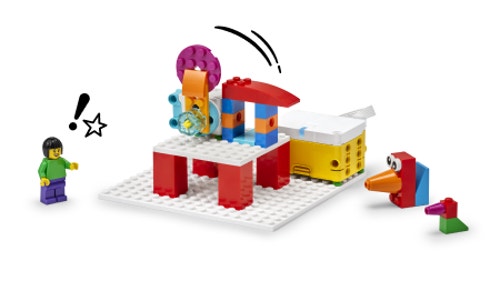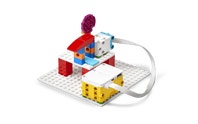Solving Problems When Environments Change
Sofie learned that people will put a building in the wetland near her home. She’s worried it will hurt the birds and other animals that live there.

Prepare
(NOTE: This lesson contains a Part A and a Part B. Both are important to access the full learning of the curriculum. If time is limited, review both parts to choose elements that meet your students’ needs.)
In this lesson, students will design and build a solution to a problem that constructing buildings in a wetland causes for a specific animal. Some problems are suggested during Engage and some example solutions are provided for inspiration. Encourage students to design and build a solution for the animal and problem they select.
- Build Prior Knowledge - Solving Problems Caused by Environmental Change: Using your core science materials, share information, images or videos and definitions to build prior knowledge.
- An environment consists of all the living and non-living things that surround and affect a plant or animal.
- Wetlands are environments where the soil is covered by fresh water, salt water or a mixture of the two for some or all of the year.
- Wetlands are home to a wide variety of animal and plant life.
- When people construct buildings in or near wetlands, they often drain the wetland or fill in the area with extra soil. This can change the environment in many ways that affect the plants and animals living there.
- A claim answers a question about a problem and is supported by an argument that uses evidence and reasoning to say why a solution will respond to the problem. Evidence may include reasons, facts and logical cause-effect relationships (adding soil could kill the plants birds use to build nests; a tall building could block the light plants need).
- Key vocabulary: environment, wetland, claim, evidence.
- Building and Programming Experience: Review the suggestions in the Unit Plan. For this lesson, you may also want to:
- Reinforce with the Motor tutorial in the SPIKE App Start menu.
- Use the Motor and Sound sections of the Help>Word Blocks menu in the SPIKE app to provide more support.
- Use the Swamp Boat lesson to introduce students to the wetlands theme.
- Materials: If you wish, locate information, images and/or videos of wetlands to use during the lesson. Search what is a wetland and use websites from government agencies or private organisations that explore and protect the environment.
PART A (45 minutes)
Engage
(Whole Class, 10 minutes)

Introduce the story’s main character(s) and the first challenge: Sofie learned that people will put a tall building in the wetland near her home. She’s worried it will hurt the birds and other animals that live there.
THINK – Facilitate a brief discussion about the lesson topic(s), using collected resources and the story picture if you wish.
- What is a wetland? (marshes and/or swamps; environments where the soil is covered by water for some or all of the year; show images and video as needed.)
- What kinds of plants live in wetlands? (tall grass-like plants, low moss-like plants, sometimes shrubs and trees)
- What kinds of animals live in wetlands? (those from local wetlands, which could include ducks and other waterfowl, beavers, muskrats, alligators, crocodiles, frogs, turtles, snakes and many different insects)
- What are some ways that building in a wetland could change it? How would these changes make it hard for plants and animals to survive? (List students’ ideas, such as that when water is drained or soil added to make space for a building, it can change water levels. This could make the ground drier or provide less water to drink. Changing water and soil levels can also destroy food sources, hiding places or nesting resources (see example solution of a bird nesting site). The building itself can change light levels by blocking the sun.)
- Choose one of these problems for one animal in Sofie’s wetland. Think about how to solve it.
Distribute a SPIKE Essential Set and a device to each group.
Explore
(Small Groups, 25 minutes)
As students work,
- Consider sharing the examples below as support for building or programming, clarifying that the examples show one solution to replace lost nesting resources. Students should build a solution for their chosen problem.
- Facilitate brainstorming about the problems they chose and ways to use LEGO® elements to show solutions for them.
Have students:
- Discuss the problem their chosen animal will have after the wetland changes, as well as their design ideas to solve that problem. What will the animal need?
- Explore their design ideas visually, such as by sketching.
- Begin to BUILD and PROGRAM a model that solves or reduces the problem, using the provided base model and program for inspiration
Example Ideas




Explain
(Whole Class, 10 minutes)
Gather students for sharing.
Have each group use their progress model and sketches to demonstrate and explain:
- What problem they chose, including what may change in the wetlands and what problem this may cause for their animal.
- How their design reduces the change to the wetlands and the problem for the animal.
- Their reasons for choosing this design to solve the problem.
- What their program does.
Elicit sharing about students’ work in progress and encourage students to use inspiration from shared ideas.
Have students keep their partially completed models intact for use in Part B, where they will Build, Program and Explain further.
PART B (45 minutes)
Explain
(Whole Class, 10 minutes)
- Repeat the steps from Part A – Explain to have additional groups demonstrate and explain their learning.
Elaborate
(Whole Class, 25 minutes)
Have students:
- (10 min) Continue to BUILD and PROGRAM, using inspiration from the sharing during Explain. For example, they might improve their solution to fit different sizes of their animal (e.g., small and large birds).
- (10 min.) Use their completed models to make a claim about how their design solution will help an animal survive after construction starts in Sofie’s wetland, supporting it with reasons and evidence.
(5 min) Invite students to share knowledge, ideas or skills that
- Helped them complete the challenge.
- They learned while building.
Have students clean up the sets and work areas.
Evaluate
(Whole Class, 10 minutes)
- Ask guiding questions to elicit students’ thinking and their decisions while ideating, building and programming.
Observation Checklist
Review the learning objectives (Teacher Support box).
Review the learning objectives and behaviours at different levels of mastery.
Use the checklist to observe students’ progress:
- They accurately describe a problem animals face when people build on a wetland, such as loss of food, hiding places or nesting resources.
- Their model shows one solution to the problem.
- They make a claim about how their design will reduce the problem for the animal.
- They support their claim with evidence about the problems the changing wetland causes (e.g., adding soil means plants birds use for nests won’t grow and birds need another place to nest) and reasons why their design solves that problem for the animal (e.g., the birdhouse gives birds another place to nest and raise their young).
See the Additional Resources section: Self-Assessment and Peer Feedback, for more ways to Evaluate.
Self-Assessment
Have each student choose the brick that they feel best represents their performance。
- Blue brick: I think I can follow instructions to create a program.
- Yellow brick: I can follow instructions to create a program.
- Green brick: I can follow instructions to create a program and I can help a friend do it too.
Peer Feedback
In their small groups, have your students discuss their experiences working together.
Encourage them to use statements like these:
- I liked it when you…
- I’d like to hear more about how you…
Differentiation
Simplify this lesson by:
- Having all students design solutions to the same problem, such as by using the example birdhouse to solve the problem of lost nesting resources.
Increase the difficulty by: - Having students address possible variations in their chosen problem, such as that some birds like to build nests on the ground and others prefer to build high in trees and design to solve both problems.
Extension
- According to the U.S. The Department of Australian Wetlands provide habitat for all Australian endangered or threatened fish, birds and plants. Have students represent and compare these fractional parts of a whole by colouring squares, grouping blocks or some similar activity.
If facilitated, this will extend beyond the 45-minute lesson.
Teacher Support
Students will:
- Create a model showing how to solve a problem an animal faces when people build on wetlands.
- Describe the problem their design addresses.
- Make a claim about how well their design solves the problem for the animal.
- Support their claim with evidence about the problem and the reason(s) why their design solves this problem.
(one for every two students)
- LEGO® Education SPIKE™ Essential Set
- Device with the LEGO Education SPIKE App installed
- See Prepare - Materials.
ACSSU073 ACSHE051 ACTDEK012 ACTDIP011 ACELY1676 ACMMG063 ACMNA058
Science (Biological Sciences)
Year 4 Biological Diversity and Ecosystems:
ACSSU073: "Living things depend on each other and the environment to survive."
Year 4 Nature and Development of Science:
ACSHE051: "Science knowledge helps people to understand the effect of their actions."
Technologies (Design and Technologies)
Years 3 to 4 Investigating and Designing:
ACTDEK012: "Investigate food and fibre production and food technologies used in modern and traditional societies."
Technologies (Digital Technologies)
Years 3 and 4 Digital Implementation:
ACTDIP011: "Implement simple digital solutions as visual programs with algorithms involving branching (decisions) and user input."
English (Literacy)
Year 3 Speaking and Listening:
ACELY1676: "Listen to and contribute to conversations and discussions to share information and ideas and negotiate in collaborative situations."
Mathematics (Measurement and Geometry)
Year 3 Shape:
ACMMG063: "Identify two-dimensional shapes and three-dimensional objects in the environment."
Year 3 Fractions and Decimals:
ACMNA058: "Model and represent unit fractions including 1/2, 1/4, 1/3, 1/5 and their multiples to a complete whole."